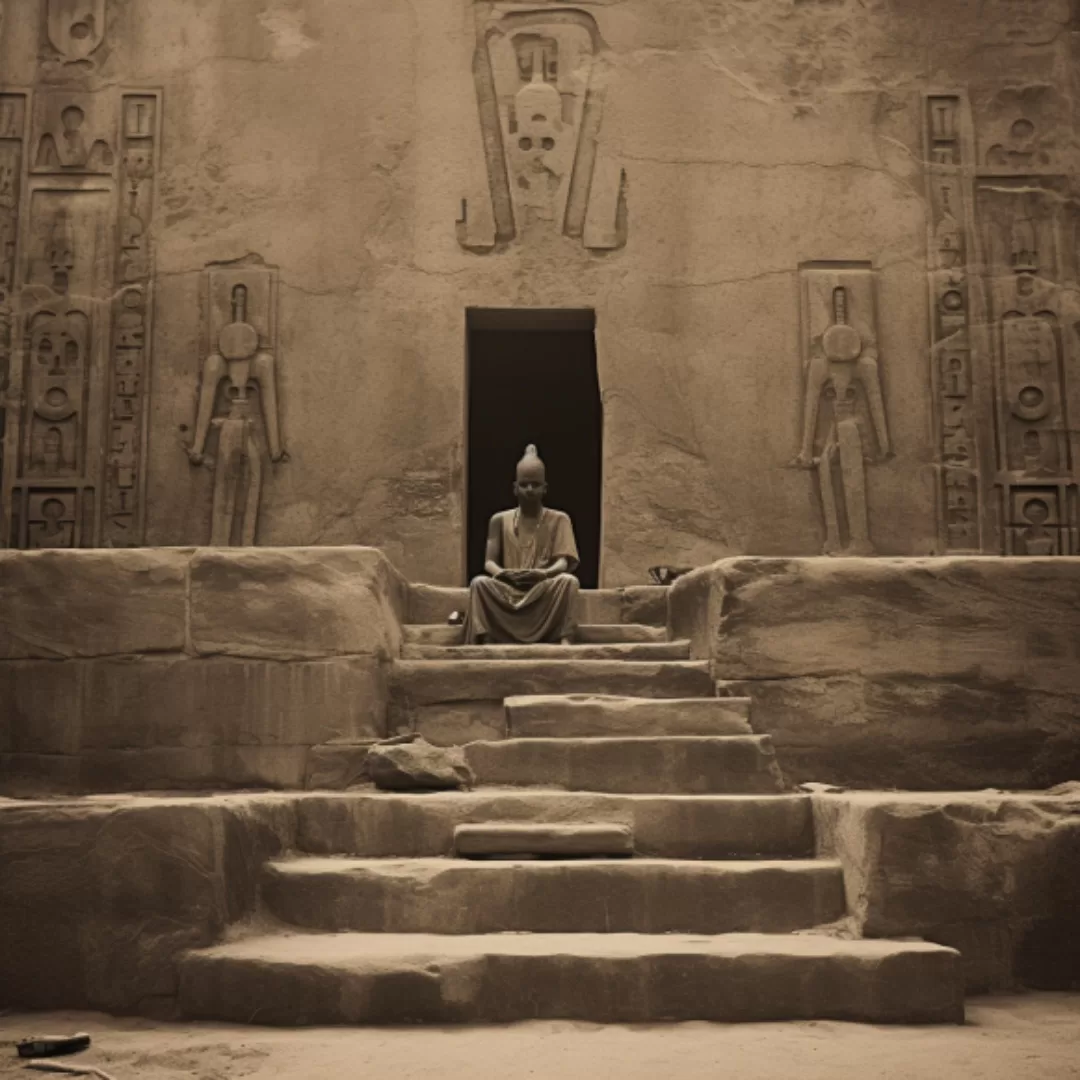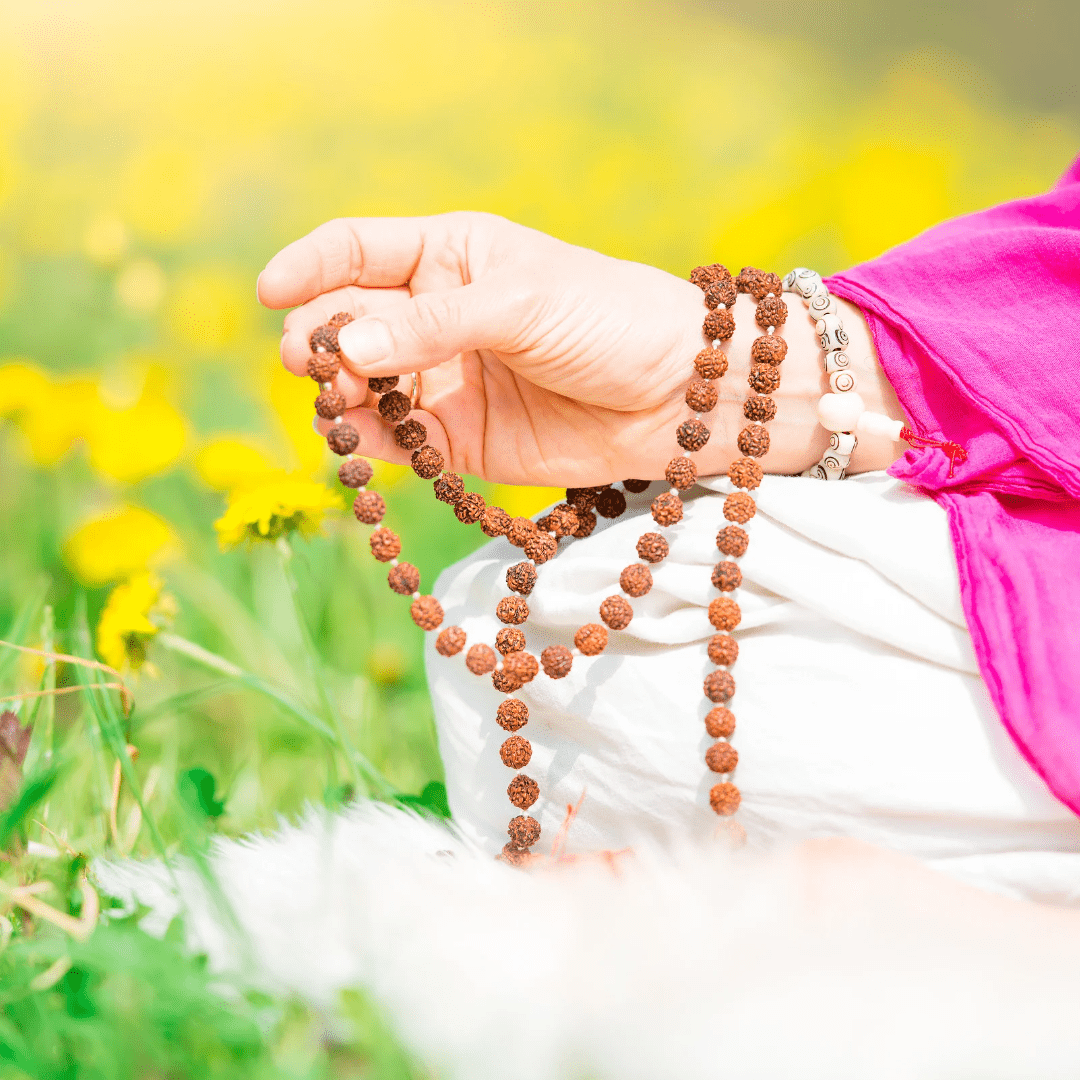In the bustling cacophony of the 21st century, many are turning their gaze backward, seeking solace in ancient practices that offer tranquility and spiritual enlightenment. One such practice that has regained prominence in recent years is Kemetic Meditation. But what is it, and how does it weave the threads of ancient Egyptian wisdom into the fabric of our modern lives?
Introduction to Kemetic Meditation
As the relentless pace of modern life quickens, an increasing number of individuals are searching for ways to find inner peace, grounding, and a deeper connection to the past. Kemetic Meditation offers a portal back to an age where spirituality was intricately woven into the tapestry of everyday life, where the cosmic dance of deities was mirrored in the flow of the Nile, and where meditation was a bridge between the earthly realm and the divine.
What is Kemetic Meditation?
Kemetic Meditation traces its origins to the spiritual heart of ancient Egypt, or ‘Kemet’. This wasn’t just a civilization known for its grand pyramids and enigmatic Sphinx. At its soul, Kemet was a land of spiritual seekers, mystics, and scholars, who perceived a deeper reality beneath the physical world.
In essence, Kemetic Meditation isn’t merely a series of relaxation techniques or ritualistic practices. It’s a pathway to understanding the self, the cosmos, and the intertwining destinies of both. Through this practice, one communes with ancient deities taps into age-old wisdom, and discovers a tranquility that, while rooted in the past, is profoundly relevant to the challenges of today.
Relevance of Kemetic Meditation in Today’s World
Our current era, dominated by digital screens, constant notifications, and fleeting moments, often leaves individuals feeling detached, restless, and yearning for genuine connection. In such times, the allure of Kemetic Meditation is even more potent.
This form of meditation offers an oasis of calm, grounding the practitioner in age-old truths and cosmic rhythms. For those feeling lost in the maze of modern existence, it acts as a compass, pointing the way to inner harmony, balance, and a deeper connection to the universe’s mysteries.
The Historical Context of Meditation in Ancient Egyptian Spirituality
To truly appreciate Kemetic Meditation, one must journey back to the sands of ancient Egypt. Here, meditation wasn’t a mere hobby or an occasional practice. It was a way of life, integral to religious rituals, daily routines, and the philosophical teachings imparted to the elite.
Priests and priestesses would often engage in deep meditative states, seeking guidance from the gods, interpreting dreams, and channeling energies for the benefit of the kingdom. The practice was seen as a means to access hidden realms, unlock deeper layers of consciousness, and communicate with the pantheon of deities that governed various aspects of life and death.
But it wasn’t reserved solely for the religious elite. Common folk too, in their ways, practiced forms of meditation to seek blessings, understand their karmic path, and attain inner peace. Whether through silent reflection by the Nile’s banks, chanting hymns in communal gatherings, or dancing in trance-like states during festivals, meditation was woven into the very fabric of Kemetic society.
As we proceed further, we’ll delve into the intricate techniques and rituals that define Kemetic Meditation, illuminating its profound impact and timeless relevance. But for now, let us sit in silent reflection, acknowledging the vast spiritual heritage that this practice encompasses, inviting us to be a part of its enduring legacy.
Kemetic Meditation as Ancient Egyptian Meditation
In the vast stretches of golden deserts and along the life-giving Nile, ancient Egyptians – or Kemites – constructed a society that seamlessly blended the mundane with the spiritual. At the heart of this civilization was a belief system that perceived the universe as a complex tapestry of interconnected energies, forces, and deities.
Ancient Deities and Their Roles
At the heart of Kemetic meditation were the gods and goddesses who played pivotal roles in the cosmos. They were not distant figures but accessible entities, with whom individuals could communicate, seek guidance, and draw inspiration. The most notable among them included:
- Ra (or Re): The Sun God, representing creation, rebirth, and the cyclical nature of life.
- Isis: A symbol of healing, magic, and motherhood, she offered protection and insight to her devotees.
- Anubis: Guardian of the afterlife, he guided souls and ensured their safe passage into the next realm.
These deities, among others, served as focal points during meditation, aiding practitioners in aligning their energies, desires, and then intentions with the divine order.
Daily Rituals and the Art of Meditation
Meditation in ancient Kemet wasn’t a secluded practice; it was also woven into the daily rituals that punctuated life. Morning rituals often began with offerings to deities, followed by meditative chants sung to the rising sun. As the day progressed, various forms of meditation – from silent reflection to dance and song – were employed to maintain a harmonious balance with the universe.
Priests and temple attendants had specialized meditative techniques. They used sacred oils, incense, and specific postures to induce deeper states of consciousness, journeying to astral realms or communicating with deities.
Education and Initiation
Kemetic mystery schools were elite institutions that offered deeper spiritual insights to chosen individuals. Aspirants underwent rigorous training, which included advanced meditation techniques, the study of sacred geometry, and alchemy, and also an understanding of the cosmos’ metaphysical aspects.
Here, meditation was both a tool and a teacher. Initiates learned to harness their inner energies, awaken dormant psychic abilities, and commune with higher realms, often using meditation as a gateway to profound mystical experiences.
In the sands of ancient Egypt, beneath the watchful eyes of the gods and amidst grand temples’ shadows, Kemetic Meditation flourished as a tool, philosophy, and way of life. Its roots dug deep into the soil of spirituality, drawing nourishment from a rich blend of myth, ritual, and cosmic understanding.
The Foundations of Kemetic Meditation
Understanding Ma’at
Central to Kemetic spirituality and, by extension, its meditation practices, is the concept of “Ma’at.” Often depicted as a goddess with an ostrich feather, Ma’at is more than a deity. She embodies the principles of truth, balance, order, harmony, morality, and justice.
In the realm of Kemetic Meditation, adhering to Ma’at meant maintaining a harmonious balance both internally and externally. Meditation sessions often began with invocations to Ma’at, seeking her guidance to ensure that the practitioner’s heart weighed no more than her feather, a symbol of leading a righteous life.
Embracing the Power of Visualization
One distinct aspect of Kemetic Meditation is the emphasis on vivid visualizations. Practitioners were taught to conjure clear mental images, whether of deities, sacred symbols, or significant events. This focus on visualization serves a dual purpose:
- Channeling Divine Energies: By visualizing a particular deity or symbol, the practitioner aligns their energy with the divine, facilitating a stronger spiritual connection.
- Manifesting Intentions: Clear visualizations act as a beacon for one’s intentions, desires, or prayers, giving them shape and direction in the ethereal realm.
Key Deities in Kemetic Meditation and Their Significance
While we’ve touched upon some primary deities earlier, it’s crucial to delve deeper into the pantheon to understand the breadth and depth of Kemetic Meditation.
- Osiris: Representing resurrection and the afterlife, meditating upon Osiris helps in understanding life’s cyclical nature and the eternal soul’s journey.
- Hathor: Goddess of love, beauty, and music, Hathor aids in fostering self-love, understanding universal love, and drawing on the healing power of music and dance.
- Thoth: The deity of wisdom, writing, and magic, invoking Thoth during meditation can lead to clearer insights, enhanced understanding, and a deeper connection to ancient wisdom.
Sacred Symbols in Kemetic Meditation
Beyond deities, Kemetic Meditation also integrates a rich tapestry of symbols, each with its unique energy and significance. The Ankh (representing life), the Djed Pillar (symbolizing stability), and the Was Scepter (denoting power and dominion) are just a few examples. Integrating these symbols into meditation helps anchor the practitioner’s intentions, invoking protection, longevity, or other specific energies.
The foundations of Kemetic Meditation are as profound as they are ancient. With a rich amalgamation of deities, symbols, and guiding principles, it offers a comprehensive spiritual toolkit for the modern seeker. While the tools and techniques might have evolved over millennia, the essence remains unchanged: a journey towards balance, understanding, and a deeper communion with the divine.
Setting the Sacred Space for Kemetic Meditation
In the spiritual realm of Kemet, every act of devotion, including meditation, wasn’t merely about the inner state of the practitioner but was also influenced by the external environment. Sacred spaces are integral to deepening the meditation experience, invoking the right energies, and establishing a direct channel to the divine.
Choosing the Right Location
The location for your Kemetic Meditation should ideally be quiet, free from disturbances, and also a place where you feel naturally calm and grounded. It could be:
- An Alcove in Your Home: A dedicated corner adorned with Kemetic symbols, images of deities, and also other spiritual paraphernalia.
- Outdoor Spots: By a serene lake, under a tree, or any place that naturally evokes feelings of peace and reverence. Ancient Kemites often meditated by the Nile, also drawing energy from its ebbing and flowing waters.
- Sacred Altars: A space with a small table or platform, where you can place sacred objects, candles, and incense.
Infusing Aromas
Scent plays a significant role in Kemetic Meditation. Fragrances can aid in relaxation, invoke specific energies, or serve as offerings to deities. Some traditional scents include:
- Frankincense: Used widely in ancient Kemet, it promotes calmness and also heightens spiritual awareness.
- Myrrh: Known to purify the environment and also usher in protective energies.
- Lotus: Revered in ancient Egypt, the lotus scent fosters clarity, spiritual awakening, and enlightenment.
Harnessing Sound Vibrations
Chants, hymns, and even the gentle lapping of water can elevate your Kemetic Meditation experience. You can incorporate:
- Ancient Kemetic Hymns: There are several recordings available that reproduce the sacred hymns, helping you immerse in their ethereal vibrations.
- Sistrum: A musical instrument used in ancient Egypt, its gentle sound can be deeply meditative.
- Nature Sounds: If you’re meditating outdoors, let the sounds of nature – birdsong, rustling leaves, flowing water – guide your meditation journey.
Sacred Symbols and Their Placement
The use of symbols, as touched upon in the previous section, can amplify the potency of your meditation space. Arrange symbols like the Ankh, Djed, and Was Scepter around your space, perhaps even using them as focal points during your meditation. Their mere presence can also act as powerful conduits for specific energies and intentions.
Establishing a sacred space is akin to laying the foundation for a temple. Each element, from the chosen location to the aroma wafting in the air, contributes to crafting a realm where the mortal meets the divine. As you immerse yourself in Kemetic Meditation, let this space be your sanctuary, a bridge that spans across millennia, also connecting you to the spiritual heart of ancient Kemet.
Step-by-Step Guide to Kemetic Meditation
Begin with Intention
Before commencing, sit comfortably and take a moment to crystallize your intention for this meditation. Are you seeking guidance, healing, clarity, or merely a peaceful commune with the deities? Vocalize or mentally affirm this intention, allowing it to guide your entire session.

Grounding Yourself
Close your eyes and take deep, calming breaths. Imagine roots sprouting from the base of your spine, going deep into the earth, anchoring you. This practice connects you to the grounding energies of the earth, offering stability during your meditative journey.
Invocation of the Deities
Based on your intention, invoke the deity or deities that align with your purpose. You could softly chant their names or visualize them, drawing their energies towards you.
For instance, if seeking wisdom and clarity, you might call upon Thoth, visualizing his ibis-headed form and seeking his blessings.
Engage in Visualization
Building on the earlier segment about the power of visualization in Kemetic Meditation, now is the time to harness it fully. Visualize sacred symbols, the mighty Nile, or any image from ancient Kemet that resonates with you. Allow this visualization to evolve, guiding you deeper into meditation.
Chanting and Mantras
Use sacred Kemetic chants or mantras that resonate with your intention. The rhythmic repetition of these sounds will enhance your focus and deepen your meditation. For instance, chanting “Ankh, Udja, Seneb” (Life, Prosperity, Health) can be a powerful mantra for overall well-being.
Engage Your Senses
If you have incorporated incense or oils into your sacred space, let their aroma guide your meditation. The gentle sound of the sistrum or nature sounds can also be integrated at this stage, immersing you further.
Deepening yourself in Kemetic Meditation
As you progress, allow yourself to go deeper. If thoughts arise, simply acknowledge them and let them pass, returning your focus to your visualization or chanting. Remember, this is a communion with the divine energies of ancient Kemet, so let it unfold organically.
Conclusion and Gratitude
As you feel the meditation coming to an end, gently draw your focus back to your physical surroundings. Before opening your eyes, express gratitude to the deities and energies that guided and protected you during the session.
Grounding Again
To ensure a smooth transition back to your regular state, revisit the grounding visualization from step two. Imagine the roots receding, but leaving you with a connection to the earth’s stable energies.
Documenting the Experience
Keep a journal nearby to document any insights, messages, or feelings you encounter during your meditation. This practice aids in understanding patterns, insights, or guidance you might receive over multiple sessions.
Kemetic Meditation, with its rich history and profound spiritual depth, is a journey of the soul, guided by the timeless energies of ancient Kemet. While the steps above offer a structured approach, remember that meditation is deeply personal. Modify, adapt, and evolve the practice as it suits you, always keeping the core principles of Kemetic spirituality in mind.
Integrating Kemetic Meditation into Daily Life
Morning Affirmations with Ma’at
Starting your day with the principles of Ma’at ensures you align with truth, balance, and harmony from the outset. Upon waking, recite affirmations like, “Today, I walk in the light of Ma’at, ensuring balance in thought, word, and action.”
Ankh Symbolism in Daily Tasks
The Ankh, symbolizing life, can be a constant reminder of the sanctity of existence. Consider wearing Ankh jewelry or keeping Ankh symbols in spaces where you spend significant time, like your workspace. Whenever you catch a glimpse, take a brief moment to ground yourself, appreciating life’s blessings.

Themed Meditative Moments
Allocate specific days of the week to meditate upon different deities. For instance, Wednesdays could be dedicated to Thoth, seeking wisdom and clarity. This breaks the monotony and keeps you connected with different divine energies throughout the week.
Sacred Spaces Everywhere
While it’s beneficial to have a dedicated meditation space at home, you can create transient sacred spaces anywhere. Carry a small pouch with sacred symbols, incense sticks, or even a small figurine. Whenever you need a moment of peace, lay them out, take a few deep breaths, and reconnect.
Mindful Meals with Hathor
Hathor, the goddess of love and nourishment, can be invoked during meals. Before eating, express gratitude for the food, imagining it to be a blessing from Hathor. This not only makes meals a spiritual experience but also promotes mindful eating.
Kemetic Journaling
Expand upon the meditation journaling practice by dedicating a few minutes each day to write about how Kemetic principles influenced your decisions, interactions, and feelings. This reinforces the teachings and provides clarity on areas of growth.
Communing with Nature
Given the Kemetic reverence for the Nile and natural elements, make it a habit to regularly commune with nature. A walk by a river, meditating under a tree, or simply tending to plants can keep you attuned to the energies of ancient Kemet.
Continuous Learning
Kemetic spirituality is vast and profound. Dedicate time weekly or monthly to delve deeper, whether it’s reading ancient texts, attending workshops, or discussing with fellow practitioners. Continuous learning enriches your practice and provides fresh insights.
Incorporating Kemetic Meditation into daily life ensures that the ancient wisdom of Kemet is not merely a practice but a lived experience. As you weave these principles into your day-to-day, you’ll find your actions, thoughts, and also emotions aligning more harmoniously with the universe, echoing the timeless ethos of ancient Egypt in contemporary settings.
Kemetic Meditation and Its Modern Relevance
Ancient Egyptian Meditation Wisdom
Kemetic Meditation isn’t just a practice; it’s also a legacy handed down through countless generations. It stands as a testament to humanity’s eternal quest for understanding, connection, and transcendence. By engaging in this meditation, you become a link in a chain that stretches back to ancient civilizations, echoing their wisdom and insights.
Modern Challenges, Ancient Solutions
In an age of digital distractions, rising stress levels, and disconnection from the self, Kemetic Meditation offers a respite. By grounding practitioners in age-old principles of balance, harmony, and introspection, it provides tools to navigate modern challenges with grace and wisdom.
Interplay of Science and Spirituality
Recent studies in the realms of neurology and psychology have highlighted the benefits of meditation, from improved cognitive functions to enhanced emotional well-being. Kemetic Meditation, while spiritual, aligns with these scientific findings, offering both spiritual growth and tangible health benefits.
Bridging Cultures and Traditions
Kemetic spirituality, while rooted in ancient Egyptian culture, transcends geographical and cultural boundaries. In today’s globalized world, it serves as a bridge, fostering understanding and appreciation among diverse groups. By practicing and promoting Kemetic Meditation, you play a part in this global tapestry of shared spiritual heritage.
Adaptable and Inclusive
One of the remarkable aspects of Kemetic Meditation is its adaptability. Whether you’re a seasoned meditator or a beginner, whether you hail from a background steeped in Kemetic traditions or are just discovering them, this practice is inclusive and flexible, making it relevant across varied contexts.
Sustainable Spirituality
At its heart, Kemetic Meditation is also about harmony with nature, as seen in the reverence for the Nile, fauna, and flora in ancient Egyptian traditions. In an age where sustainability and environmental consciousness are paramount, this practice serves as a reminder of our interconnectedness with nature and the importance of living in balance.
Kemetic Meditation is more than a journey into the past; it’s a beacon for the future. In a rapidly changing world, it offers constants – the eternal truths of balance, harmony, and connection. As you continue your journey with Kemetic Meditation, know that you’re not just honoring ancient traditions but also shaping the future, ensuring that the wisdom of Kemet resonates through the ages, always relevant, and enlightening.
Further Resources for Expanding Your Kemetic Meditation Journey
Recommended Readings about Kemetic Meditation
- “The Kemetic Tree of Life” by Muata Ashby: A deep dive into the metaphysical teachings of ancient Egypt, this book decodes the spiritual practices and philosophies of the time.
- “Temple of the Cosmos: The Ancient Egyptian Experience of the Sacred” by Jeremy Naydler: Explore the spiritual and cosmological insights of ancient Egypt and understand their perception of the divine cosmos.

Online Communities and Forums for Kemetic Meditation
- Kemetic Meditation Groups: Websites like Meetup.com often host groups dedicated to Kemetic spirituality and meditation. Joining these can also provide support and shared insights.
- Discussion Boards: Platforms like Reddit have communities (subreddits) like r/Kemetic where enthusiasts and practitioners discuss their experiences, share resources, and also answer queries.
Workshops and Retreats for Kemetic Meditation
Many spiritual centers around the world offer Kemetic Meditation workshops and retreats. Immersing yourself in such environments can be transformative, allowing deepened practice and also the connection with like-minded individuals.
Virtual Classes and Webinars
With the digital age upon us, there are countless online platforms offering courses on Kemetic spirituality and meditation. Platforms like Udemy, Coursera, and even YouTube channels dedicated to Kemetic practices can also be invaluable resources.
Museums and Historical Tours
If you ever get the opportunity, visiting museums with extensive Egyptian exhibits or even traveling to Egypt can also be deeply enriching. Walking in the same lands, seeing the artifacts, and then experiencing the energy of ancient temples can elevate your understanding and connection.
Connect with Scholars and Experts
There are many scholars and experts in Kemetic spirituality who offer lectures, write articles, or even provide one-on-one guidance. Engaging with them can also offer deeper insights and clarity.
Daily Rituals and Practices Related to Kemetic Meditation
To truly integrate Kemetic Meditation into your life, also consider establishing daily rituals. Whether it’s lighting incense in honor of a deity, dedicating a few moments each day to silent contemplation, or reading a verse from ancient texts, these rituals can keep you connected to the practice.
Conclusion
Kemetic Meditation is a lifelong journey, and like all journeys, the paths to explore are infinite. The resources and avenues listed above are just a starting point. As you delve deeper, you’ll discover more tailored paths and also resources that resonate with your unique spiritual journey. Remember, the essence of Kemetic Meditation lies in seeking, understanding, and also connecting. Let these principles guide you, and also you’ll find the wisdom of ancient Kemet illuminating every step of your path.












